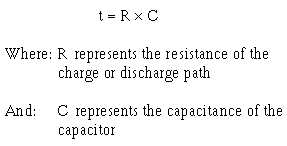3-14
From the formula, you can see that if frequency or capacitance is increased, the XC will decrease.
Since filter capacitors are placed in parallel with the load, a low XC will provide better filtering than a
high XC. This is done by providing a better shunting effect of the ac around the load, as shown in figure
3-15.
Figure 3-15.—Capacitor filter. Fast charge time
To obtain a steady dc output, the capacitor must charge almost instantaneously to the value of
applied voltage. Once charged, the capacitor must retain the charge as long as possible. The capacitor
must have a short charge time constant (view A) and a long discharge time constant (view B). This can be
done by keeping the internal resistance of the power supply as small as possible (fast charge time) and the
resistance of the load as large as possible (slow discharge time).
From your earlier studies in basic electricity, you may remember that one capacitor time constant is
defined as the time it takes a capacitor to charge to 63.2 percent of the applied voltage or to discharge to
36.8 percent of its total charge. This can be expressed by the following equation:
You should also recall that a capacitor is considered fully charged after five RC time constants.
Referring to figure 3-16, you should see that to obtain a steady dc output voltage, the capacitor should
charge rapidly and discharge as slowly as possible.



